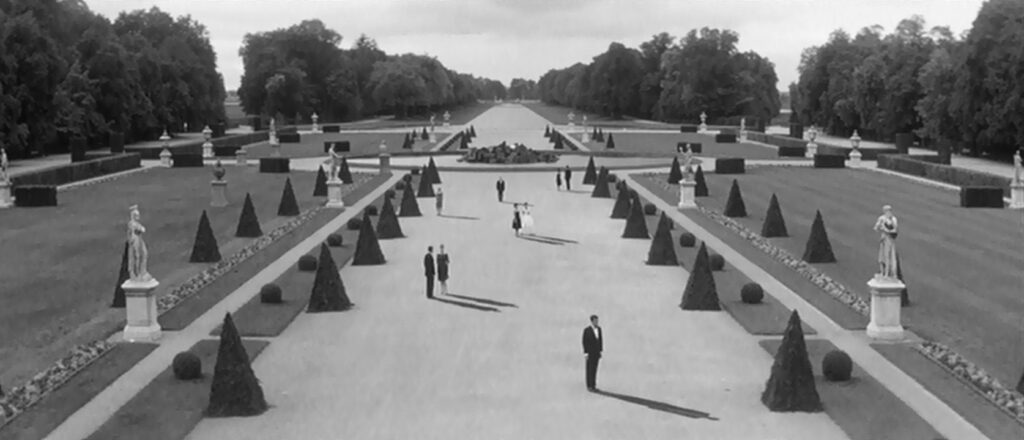
Last Year at Marienbad
1961, directed by Alain Resnais
In the garden behind the baroque hotel in Last Year at Marienbad is a statue of a man and a woman. The male figure holds his right arm across his chest like a barricade, while the female reaches forward with her left, as if pointing. The two leading characters, the unnamed woman (Delphine Seyrig) and her suitor (Giorgio Albertazzi), discuss possible readings of the statue. Is the man holding the woman back from some danger? Or does she notice something that the man hasn’t seen?
The statue keeps changing its position and its orientation. Sometimes it’s on the terrace near the hotel, sometimes by the fountain at the far end of the garden. Sometimes it points one way, sometimes another. The film was shot mainly at Nymphenburg and Schleißheim palaces, and the statue appears on the grounds of both. It’s clearly a fictional object, and being fictional gives it importance – it’s not merely an accident of the filming location. The statue is a model of ambiguity, and it’s hard to escape thinking that it’s a summary of the film itself, which is so replete with ambiguity.
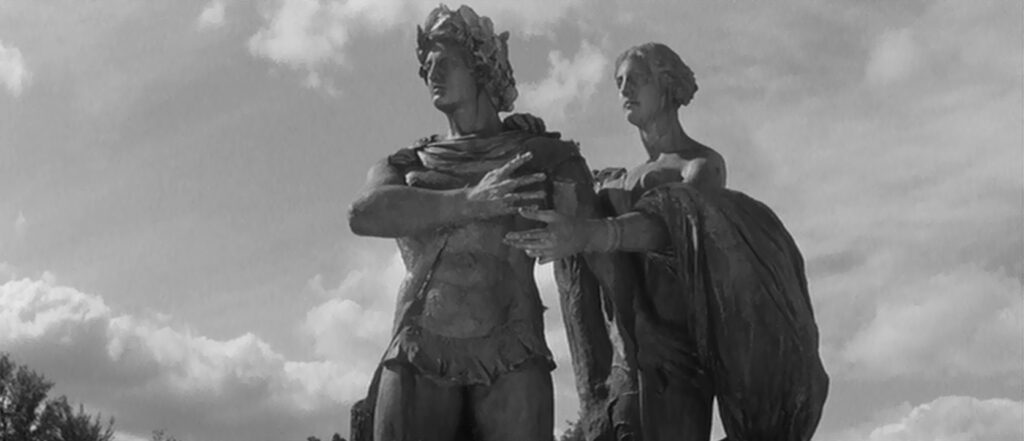
The meaning of the statue depends on whether the viewer gives primacy to the man or the woman. Either he spots danger and acts to keep her safe, or she spots something remarkable and gestures to show him. Last Year at Marienbad likewise hinges on whether we ascribe initiative to the man or the woman – but the catch is that most viewers will automatically give more agency to the suitor. For all of the story’s ambiguity, one plot point seems certain – the man is trying to seduce the woman and take her away from her husband.
The ambiguity, it seems, lies in whether the woman and her suitor had met the year before at some spa, possibly Fredericksbad or Marienbad or Karlsbad. From this premise further ambiguities arise: Is the woman suppressing a memory of rape? Has she decided since their last meeting to remain faithful to her husband? Is her suitor lying? None of the available interpretations however are satisfying. If the woman is a passive target, if the man is a common seducer asking “Haven’t I seen you somewhere before?” then the story is disappointingly shallow underneath the gorgeous photography, haunting music, and mysterious staging. To bring the movie to life we must look for another reading, and the statue gives us a clue.
By the logic of the statue, the alternative should make the movie her story. That, however, would sacrifice the one seemingly solid fact that Last Year at Marienbad repeats incessantly – that the man is trying to pry her away from her husband. How can we believe otherwise? The answer is in the opening, if only we watch closely.
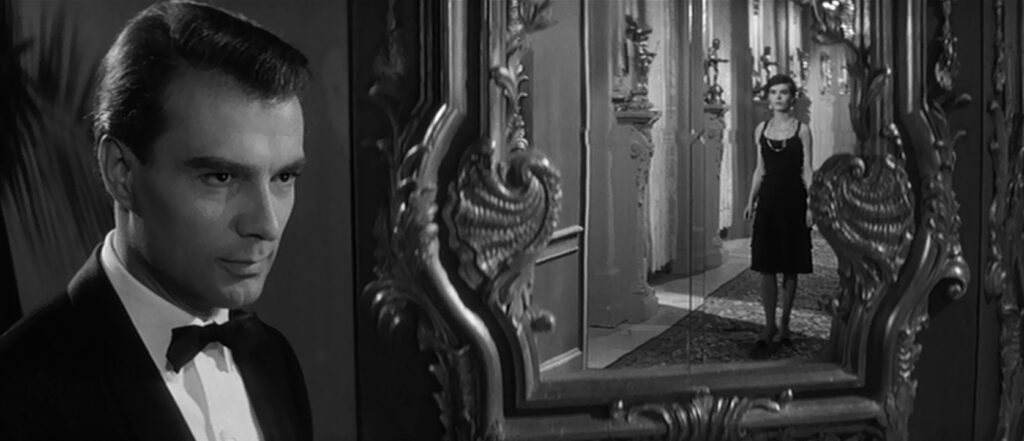
Viewers who are familiar with The Cabinet of Dr. Caligari may notice a few similarities. Both films are built around love triangles, and both cast doubt on the truth of what happens on screen. Both are full of ambiguity, and the strange discontinuities in Marienbad substitute for the physical distortions in Caligari. One could imagine that Francis, Jane, and Alan have been dressed up, given voices, and moved from an expressionist setting to a baroque one. More to the point, Caligari reveals its logic if we question the absence of one major character from the framing story at the end. Last Year at Marienbad does not exactly have a framing story, but it is bracketed by two performances of Ibsen’s play Rosmersholm (abbreviated to “Rosmer” on the poster) in the hotel’s theater. The woman and her husband make their first appearance in the play’s audience – but Albertazzi’s character is absent.
The appropriate conclusion from the suitor’s absence would sound too fanciful unless we’ve paid careful attention to the opening. Last Year at Marienbad opens with a long tour of the grand hotel, with a voice-over – Albertazzi’s – describing the carpets and stucco and columns of the baroque palace in a repetitive hypnotic patter. His voice finally segues into the play as an actor takes over his lines, fitting his mesmerizing descriptions into the drama before persuading the woman on stage to succumb to his seduction. The play ends with his triumph as the actress speaks the final line: “Voilà. Maintenant, je suis à vous.” The play and the movie ultimately reflect each other – each is split between two settings, a formal garden and a baroque interior, and like the man on the stage Albertazzi will finally win, taking Delphine Seyrig away with him.
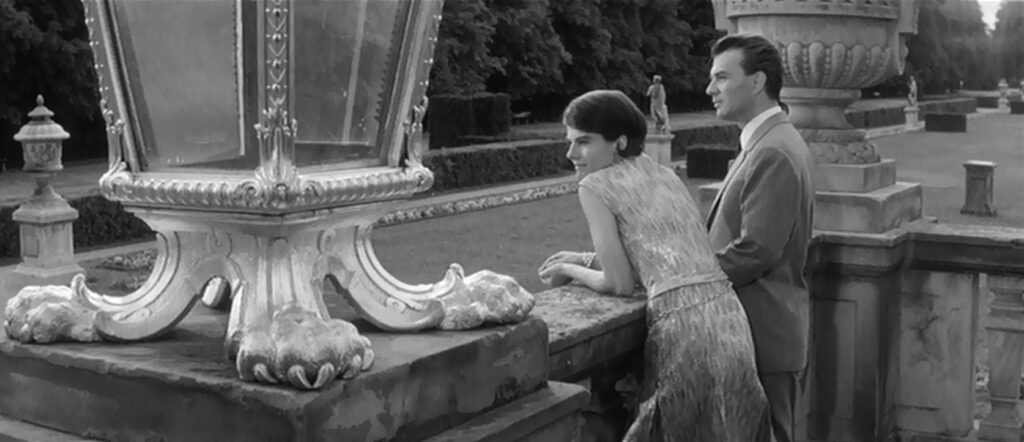
Now let’s look at the same sequence through the woman’s eyes. We can gather from the way she lingers afterward that she’s been deeply absorbed in the play, but instead of hearing the actor’s voice she hears another man – possibly a man she met at another spa a year ago. Fantasizing about this man, she inserts herself into the play, identifying so strongly with the woman onstage that when the seduction closes at the end, she is beyond the point of no return. From that moment her marriage is effectively over. She will spend the rest of the movie lost in her private fantasy, imagining her lover in the hotel unattached to anyone else. Her resistance is part of the fantasy, constantly confirming his desire and flattering her.
Albertazzi’s character, in other words, may or may not exist, but from this point of view he’s not present with the woman and her husband in the hotel. She may have had an affair with him a year ago, or she may have refused an affair and regrets it now. What’s important is that she’s entirely absorbed in her fantasy. Identifying with the woman in Rosmersholm explains her trademark gesture, holding her hand near her shoulder much as the woman on the stage held her hand to her heart. She imagines her husband and her beloved occasionally interacting, but making her husband out to be a tyrant she pictures him going around playing a game that he always wins. As with any unreliable narrator, however, fragments of truth peek out… her husband (Sacha Pitoëff) is the most nuanced of all the performances, and there are plenty of signs that he genuinely loves his wife.
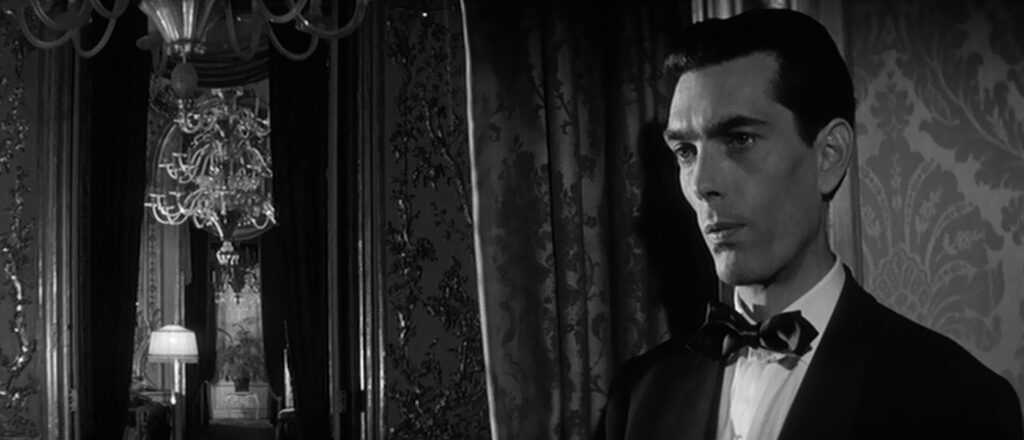
When the first performance of Rosmersholm ends, the woman is so transfixed that the other hotel guests appear frozen in time. Gradually people start to move and speak, but she hears only fragments of conversation, including a comment about a woman with an overactive imagination right after she first conjures her lover. Reality never quite returns to normal, and everything we see reflects the leaps of fancy happening in her mind. Her lover rarely appears apart from her, while she often appears by herself or alone with her husband in scenes her lover would never be privy to. If we’re willing to accept that the lover is not in the hotel, the movie becomes stronger – which is a good test of any interpretation.
At the end the husband attends the play a second time, but without his wife, who sits by the stairway awaiting her lover. At the appointed time the adulterous couple leaves together, and the husband comes downstairs in time to watch them go, but too late to win her back. As the woman and her lover exit the scene, a giant pair of curtains frames them dramatically. The curtains simulate a theater stage, implying that the woman, lost forever in her fantasy world, is retreating back into the play, leaving reality behind as her husband looks on helplessly. She and her lover do not look at each other, because he belongs to her imagination.
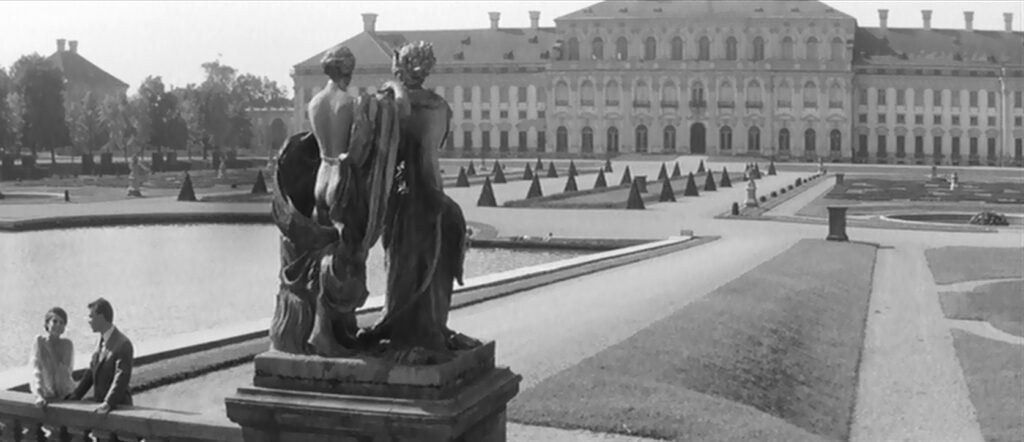
From this point of view Last Year at Marienbad is about the dangers of fantasy. Fantasy may seem harmless, but it can corrode relationships and separate people from reality. When the woman walks off at the end, she will likely be alone the rest of her life – emotionally if not literally. Now the movie’s last words make sense:
“…where even now you were losing your way forever, in the stillness of the night… alone, with me.”
The last three words (in French, “seul, avec moi”) are spoken as if there’s a comma after “alone”. They do not mean “you and I apart from everyone else”. The paradox is intentional. She is utterly alone because the speaker lives only in her fantasy.
CONNECTIONS:
The Cabinet of Dr. Caligari – Ambiguous love triangle; missing character in key location; garden bench
Brief Encounter – Plot about a married woman’s romantic affair; question as to whether the husband is as bad as his wife thinks
Le beau Serge – Radical exercise in ambiguity, representing an extreme of either realism or formalism
Carnival of Souls – Organ music, ghostly figures dancing; palace in silhouette
The Shining – Large hotel with a barroom and long corridors that don’t connect logically; formal garden or maze outside; startling multiplication of a photo or a sentence
The Cook the Thief His Wife and Her Lover – Curtains at the end (or also beginning) to signal theatricality
Burning – Hazards of fantasy